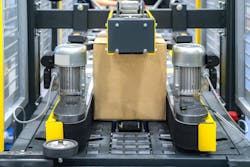Industry 4.0 is one of most searched terms on industrial digitization, according to Google Trends. The most popular related search phrase is ‘What is Industry 4.0?’
This indicates that, amid all the interest in Industry 4.0, there remains a lack of clarity about what it really means. And though the term has expanded significantly since its introduction as a German industry/government/academic initiative at Hannover Messe in 2011, it remains centered on the digital transformation of the manufacturing industries.
Helping to clarify what Industry 4.0 means for manufacturers worldwide, Claudia Jarrett, U.S. country manager for industrial parts supplier EU Automation, explains that it is “an idea and vision that, to implement properly, requires planning, cultural change, and new technology.”
Despite the massive change represented by Industry 4.0, Jarrett noted that Industry 4.0 “doesn’t require an entire system overhaul, nor does it require investment in expensive and state-of-the-art technology. A major factory overhaul is not the only path to digitalization. Retrofitting a few key components can be an easy, quick, and cost-effective way to take the first steps in Industry 4.0.”
The type of retrofitting Jarrett refers to involves adding connectivity to existing machines, allowing them to communicate over the Internet and be remotely monitored. “The simplest way to do this is to add sensors for data acquisition, or invest in technology to measure vibration, temperature, current, and power consumption,” she said. “These parameters indicate how equipment is performing and can communicate this information automatically. For example, an accelerometer could measure the frequencies at which the rotating elements of a machine vibrates. An increase in vibration amplitude signals a problem in the rotational elements of the machine, such as insufficient lubrication. This information can be communicated to a maintenance engineer trained in vibration analysis, who will be able to identify the issue and schedule the necessary repairs before the machine breaks, causing unexpected and costly downtime. This is the reality of Industry 4.0 in practice.”
Jarrett said that it is not necessary for manufacturers to purchase a new machine with embedded connectivity or overhaul the way they currently manage equipment maintenance to start down the path toward Industry 4.0. “Adding an accelerometer is enough,” she said. “Realistically, most Industry 4.0 transformations can be achieved in a similarly simple and cost-effective manner.”
Another effective step approach to Industry 4.0 is via obsolescence management. “Manufacturers should make a list of components on site that are already obsolete and rank them by importance,” said Jarrett. “Critical applications, which are essential to operate the entire system, should be prioritized. Using this method, manufacturers won’t be forced to embark on a system overhaul if something breaks down. This also addresses problems related to compatibility, which are common issues for manufacturers investing in new technology to work alongside legacy equipment. Obsolescence is the natural consequence of continuous advances in technology and Industry 4.0 increases this. Though it is impossible to eliminate obsolescence completely, taking the retrofitting approach to Industry 4.0 can lessen the potential impact.”
Though Industry 4.0 can be a confusing and intimidating process for manufacturers, Jarrett stressed the importance for manufacturers to understanding that it can be achieved through small and incremental investments. Taking small retrofitting steps, combined with a clear obsolescence management plan, is an achievable way of implementing Industry 4.0 so that it is not the intimidating process it may seem to be at first, she said.



